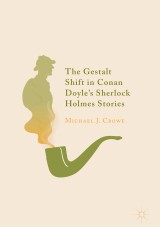Details

The Gestalt Shift in Conan Doyle's Sherlock Holmes Stories
|
60,98 € |
|
| Verlag: | Palgrave Macmillan |
| Format: | |
| Veröffentl.: | 10.10.2018 |
| ISBN/EAN: | 9783319982915 |
| Sprache: | englisch |
Dieses eBook enthält ein Wasserzeichen.
Beschreibungen
<p></p><p>This book analyzes the four novels and fifty-six stories written by Sir Arthur Conan Doyle describing the adventures and discoveries of Sherlock Holmes. Michael J. Crowe suggests that nearly all the Holmes stories exhibit the pattern known as a Gestalt shift, in which suddenly Holmes’s efforts reveal a new perspective on the case, typically identifying the culprit(s) and resolving the case. Drawing on ideas presented by Thomas S. Kuhn in his famous <i>Structure of Scientific Revolutions</i> (1962), Crowe argues that similar to the way that Kuhn applied the idea of a Gestalt shift to the history of science, this approach can be used to reveal the structure of the Holmes stories and possibly be applied to some other areas of fiction.</p><br><p></p>
<p>1. Introduction.- 2. The Four Holmes Novels.- 3. <i>The Adventures of Sherlock Holmes</i> (1892).- 4. <i>The Memoirs of Sherlock Holmes</i> (1894).- 5. <i>The Return of Sherlock Holmes</i> (1905).- 6. <i>His Last Bow</i> (1917).- 7. <i>The Case Book of Sherlock Holmes</i> (1927).- 8. Conclusion: The Sixty Holmes Stories.</p>
<div><p><b>Michael J. Crowe</b> is the Rev. John J. Cavanaugh, C.S.C. Professor Emeritus in the Program of Liberal Studies and Graduate Program in History and Philosophy of Science at the University of Notre Dame, USA. This is the eleventh book he has published and his second book on Sherlock Holmes.</p><br></div>
<p>This book analyzes the four novels and fifty-six stories written by Sir Arthur Conan Doyle describing the adventures and discoveries of Sherlock Holmes. Michael J. Crowe suggests that nearly all the Holmes stories exhibit the pattern known as a Gestalt shift, in which suddenly Holmes’s efforts reveal a new perspective on the case, typically identifying the culprit(s) and resolving the case. Drawing on ideas presented by Thomas S. Kuhn in his famous <i>Structure of Scientific Revolutions</i> (1962), Crowe argues that similar to the way that Kuhn applied the idea of a Gestalt shift to the history of science, this approach can be used to reveal the structure of the Holmes stories and possibly be applied to some other areas of fiction.</p>
<p>Reframes our understanding of Conan Doyle’s narrative structures</p><p>Connects Kuhn and theories used in the study of the history of science with detective fiction</p><p>Provides a readable and engaging new contribution to Sherlock Holmes studies</p>
“Wow, Michael Crowe’s book is a great rarity, something new under the Sherlockian Sun. Critically, his thesis is convincing and far-reaching. It provides a structure for most of the plots, and it explains why the ‘literary agent’ (Doyle) was able to write so much better than almost all other imitators. It also provides a structure for understanding many of the better books and movies in the mystery genre.” (Bradley Schaefer, Distinguished Professor and Alumni Professor of Astronomy at Louisiana State University, USA)<p>“The ‘Aha!’ moment when Sherlock Holmes finally puts it all together and the solution clicks into place with perfect clarity. In this fascinating and accessible read, Professor Crowe provides his own ‘Aha!’ presenting Sherlockians a new prism through which to understand Holmes’s genius, case by case. A must-read for fans!” (Barbara Barnett, author of Chasing Zebras: The Unofficial Guide to House, M.D. (2010) and The Apothecary’s Curse (2016))<br></p>
Diese Produkte könnten Sie auch interessieren:

The Enigma of Good and Evil: The Moral Sentiment in Literature

von: Anna-Teresa Tymieniecka

309,23 €















